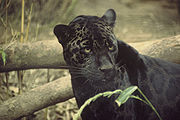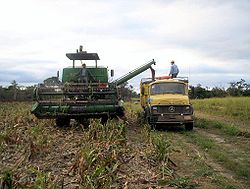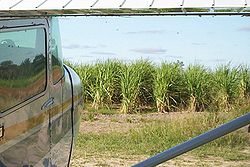
Alto Paraguay Department
Encyclopedia
Alto Paraguay is a sparsely populated department
of Paraguay
. The capital is the town of Fuerte Olimpo
.
In 1992 the Chaco Department
was merged with Alto Paraguay, effectively recreating the original department Olimpo as it existed until 1945.
 Alto Paraguay contains a varied and large amount of natural resources, which is why this department is home to several national parks, each with different characteristics. The Defensores del Chaco National Park is the largest in the Paraguayan territory. The mentioned park is home to the hill Cerro León, which is the highest point in the northern region of Paraguay. The dry surface is optimal for the growth of different kinds of cactus
Alto Paraguay contains a varied and large amount of natural resources, which is why this department is home to several national parks, each with different characteristics. The Defensores del Chaco National Park is the largest in the Paraguayan territory. The mentioned park is home to the hill Cerro León, which is the highest point in the northern region of Paraguay. The dry surface is optimal for the growth of different kinds of cactus
. Another park in this department, Parque Nacional Río Negro, is located in an area with several small lakes and is home to most of the fauna
in the department. Other national parks in Alto Paraguay are Parque Nacional Coronel Cabrera and Parque Nacional Chovoreca, which reside in dry regions.

 Paraguay's largest reserves of undeveloped fertile virgin forest covered land and lowest land prices are found in Alto Paraguay; thus, agriculture and cattle farming are starting to make inroads. The fertility of the Chaco's deep sedimentary soils is generally high, except in the westernmost parts, where there are very sandy soils, and some seasonal wetlands in the eastern plain. Annual rainfall is sufficient in the east (around 1200mm), fair in the center (around 900mm) and scarce in the west (around 700mm).
Paraguay's largest reserves of undeveloped fertile virgin forest covered land and lowest land prices are found in Alto Paraguay; thus, agriculture and cattle farming are starting to make inroads. The fertility of the Chaco's deep sedimentary soils is generally high, except in the westernmost parts, where there are very sandy soils, and some seasonal wetlands in the eastern plain. Annual rainfall is sufficient in the east (around 1200mm), fair in the center (around 900mm) and scarce in the west (around 700mm).
The most challenging aspect for farmers is the lack of decent roads and infrastructure.
The advance of agriculture is inevitably at the expense of the area’s native forest. During the two decades 1990 to 2010 Paraguay had one of the highest deforestation rates worldwide. The World Land Trust
estimates deforestation in the Paraguay Chaco at over 200.000 hectare for 2008 alone
The department's most important activity by far is cattle ranching, both extensive in the savannas of the east and intensive on the planted pastures of cleared land.
Cultivation of sorghum, sugar cane and (in planning stage as of January 2009, for the arid west) jatropha
are very recent developments.
Department (subnational entity)
Department is the name given to the administrative and political subdivisions of many countries.As a territorial unit, "department" was first used by the French Revolutionary governments, apparently to emphasize that each territory was simply an administrative sub-division of the united sovereign...
of Paraguay
Paraguay
Paraguay , officially the Republic of Paraguay , is a landlocked country in South America. It is bordered by Argentina to the south and southwest, Brazil to the east and northeast, and Bolivia to the northwest. Paraguay lies on both banks of the Paraguay River, which runs through the center of the...
. The capital is the town of Fuerte Olimpo
Fuerte Olimpo
Fuerte Olimpo is a city in Paraguay. It is the capital of the department of Alto Paraguay.Capital of Alto Paraguay Region, far from Asunción 838 km, located on Paraguay River, originally called Fuerte Bordón...
.
In 1992 the Chaco Department
Chaco Department
The Paraguayan Chaco or Región Occidental is a semi-arid region in Paraguay, with a very low population density.The Chaco is a large geographic area that is sparsely populated. Many of those living in the region are native peoples...
was merged with Alto Paraguay, effectively recreating the original department Olimpo as it existed until 1945.
Nature and national parks

Cactus
A cactus is a member of the plant family Cactaceae. Their distinctive appearance is a result of adaptations to conserve water in dry and/or hot environments. In most species, the stem has evolved to become photosynthetic and succulent, while the leaves have evolved into spines...
. Another park in this department, Parque Nacional Río Negro, is located in an area with several small lakes and is home to most of the fauna
Fauna
Fauna or faunæ is all of the animal life of any particular region or time. The corresponding term for plants is flora.Zoologists and paleontologists use fauna to refer to a typical collection of animals found in a specific time or place, e.g. the "Sonoran Desert fauna" or the "Burgess shale fauna"...
in the department. Other national parks in Alto Paraguay are Parque Nacional Coronel Cabrera and Parque Nacional Chovoreca, which reside in dry regions.
Agriculture, livestock and deforestation


The most challenging aspect for farmers is the lack of decent roads and infrastructure.
The advance of agriculture is inevitably at the expense of the area’s native forest. During the two decades 1990 to 2010 Paraguay had one of the highest deforestation rates worldwide. The World Land Trust
World Land Trust
The World Land Trust is a UK-based nonprofit environmental organization established in 1989. Its primary aims are to ensure conservation of plants, animals and natural communities in areas at risk...
estimates deforestation in the Paraguay Chaco at over 200.000 hectare for 2008 alone
The department's most important activity by far is cattle ranching, both extensive in the savannas of the east and intensive on the planted pastures of cleared land.
Cultivation of sorghum, sugar cane and (in planning stage as of January 2009, for the arid west) jatropha
Jatropha
Jatropha is a genus of approximately 175 succulent plants, shrubs and trees , from the family Euphorbiaceae. The name is derived from the Greek words ἰατρός , meaning "physician," and τροφή , meaning "nutrition," hence the common name physic nut. Mature plants produce separate male and female...
are very recent developments.
Districts and cities
The department is divided into four districts:- Bahía Negra
- Carmelo Peralta
- Fuerte OlimpoFuerte OlimpoFuerte Olimpo is a city in Paraguay. It is the capital of the department of Alto Paraguay.Capital of Alto Paraguay Region, far from Asunción 838 km, located on Paraguay River, originally called Fuerte Bordón...
- Puerto Casado
See Also
- List of high schools in Alto Paraguay

